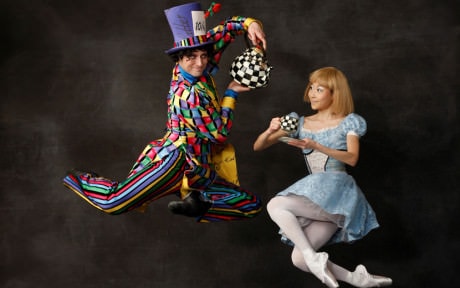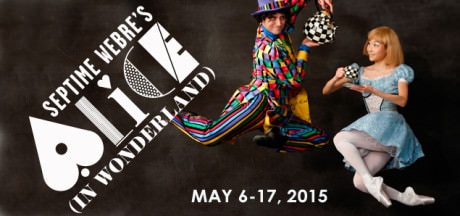The Washington Ballet‘s performance of ALICE (in wonderland) is delightful for someone like me who is not a connosseur of ballet. Here, sets and costumes change frequently, the performances are buttressed by a fine score conducted by Matthew Pierce, and you’d have to have been comatose for most of your life to not know the plot of Alice in Wonderland. White Rabbit, check; Mad Hatter, check; Queen of Hearts, check; Alice in a blue dress with white apron, check.

ALICE (in wonderland) premiered in 2012 and was the brainchild of Washington Ballet Artistic Director Septime Webre. Much of the performance is highly creative, whimsical, and entertaining. Alice is played by Maki Onuki, a dainty and sprightly dancer who springs between effortless turns to purposeful doll-like stiffness. For this production, Choreographer Septime Webre has added a prologue to Lewis Carroll’s work which presents Alice and her family as characters that are later transformed into those in Wonderland. This is an interesting move, but it’s not clear it’s for the better: Alice stands apart from her family, a fragile child alienated by her zany relatives. Lewis Carroll (who later appears as the Mad Hatter in her reverie) takes to her in a vaguely disturbing maneuver, getting her alone where she falls asleep. This backdrop lends Alice’s dream a sadder, more disturbing bent than one may be used to in the tale.
Set design by James Kronzer is varied and often works quite well, with at least a dozen set changes lending itself to the mysterious and magical world of Wonderland. The Queen of Hearts’ palace in the near-final scene is a fantastic vision with gilded thrones, columns of roses and cards, and frenetic pacing – but we see too little of it, while we see too much of the rose garden, which is overloaded with the color red, from the backdrop as the inner depths of a single red rose to the prancing red tights of the card dancers to the red, red sheen of the Queen herself. Generally, the set, the lighting design by Clifton Taylor, and the puppet design by Eric Van Wyk, synergize with each other, though a few of the scenes ring monochromatic.
The suspension of Alice to signify her descent into Wonderland – with the shifting sizes of the doors and dancers – is a neat trick to plunge us into Wonderland. Once we’re there, we move into one of the standout performances of the whole show: that of Brooklyn Mack as the Dodo Bird. Mack’s solo is mesmerizing, and the number with Mack, the Eaglet Ayano Kimura, and the flamingos in a pseudo-waltz made me want to pirouette my way home. Another standout is the transformation of the Caterpillar to the Butterfly, with Caterpillar Sona Kharatian supported by five dancers that lend her movements the undulating machinations needed to mimic a caterpillar’s iterative slither.

Unfortunately at my performance some of the technical elements were a bit off, even to an amateur like myself. Some of the group numbers revealed dancers that were out of sync, and many of the young dancers, while charming, were particularly off. Costume design by Liz Vandal was uneven; several of the costumes were rich in detail and balance. I was a particular fan of the Queen of Hearts’ costume (Sona Kharatian, again), with her curled crown, sequined open tutu, and trio of hearts centered on her crotch, [though it may not be for everyone]. However, Alice’s dress, a crushed velvet take on the traditional Alice blue dress with white apron, came off a bit Mariah Carey singing Santa Baby mixed with another favorite Alice, the matronly Alice in the Brady Bunch. A couple of the other choices are right on: the Fish and Frog costumes (allegedly modeled after David Bowie and Elton John) are marvels, from shimmery scales to an eye-popping green. I was startled, by the Dutchess’ flimsy costume which looked like one of the $10 Halloween costumes I wore year after year as a hand-me-down as a kid, that may or may not have originated as a trash bag before puffy paint got to it.
The Cheshire Cat, one of my favorite Alice in Wonderland characters, is more alley cat than bewitching sphinx, and the Mad Hatter, one of my other favorites, has mysteriously baggy pants that prevented me from being able to fully enjoy him while he danced on the table at the tea party. And as any good dance fan knows, you have got to be able to watch the legs. This is another weak point: the set at times overwhelms the dance. For example, the fog machine is cranked up at two points, both times with so much fog that you can’t see movements of the dancers, particularly the White Rabbit, who was otherwise a very fine performer skilled at nailing the mid-air double jump of real-life rabbits.
There is much to love about this The Washington Ballet’s Alice in Wonderland. The show moves quickly, with much afoot in a calvacade of sensory enchantment: Alice’s Wonderland is colorful, mystical, and I’d certainly feel blessed were I to end up in either the real Wonderland, or this one, late on a Friday night.
Running Time: Approximately 2 hours, with one 15-minute intermission.
ALICE (in wonderland) plays through May 17, 2015 at The Eisenhower Theater at the Kennedy Center – 2700 F Street, NW in Washington, D.C. For tickets, call the box office at (202) 467-4600, or purchase them online.





